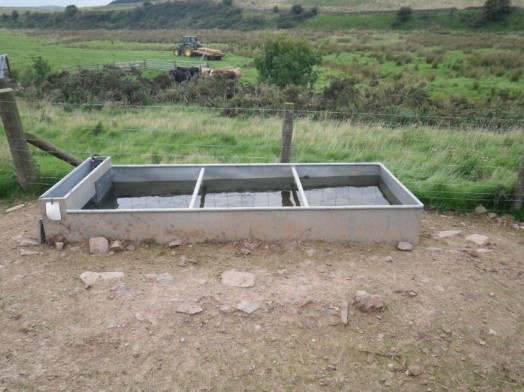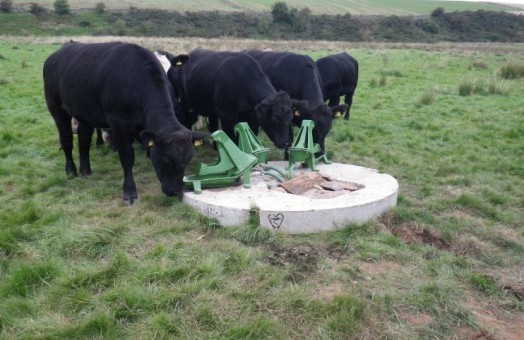Supporting guidance for Alternative Watering
Date published: 17 December, 2021
Where livestock, particularly cattle, have direct access to watercourses there is a high risk of pollution occurring from poaching and erosion of the banks. These risks can be greatly reduced by providing drinking troughs at locations which do not impact on a watercourse.
What needs to be done

1. Assessing the need for alternative watering facilities
Note: Where an assessment has been carried out as part of the diffuse pollution audit there is no need to carry out the assessment noted below.
Alternative watering facilities can be required for a variety of reasons.
This may include:
- the creation of a new feature which prevents livestock accessing existing watering points e.g. creation of a new fenced buffer strip or other new fencing next to a watercourse
- the desire to minimise the risk of poaching and erosion of watercourse
In the latter case, an assessment should be made of the risks grazing livestock can pose to watercourses in terms of poaching and erosion of the banks.
In this instance, the following factors should be considered:
- evidence of existing poaching and erosion which may be present. In some cases, existing areas of insignificant poaching may become significant over time
- stocking rates – in general the greater the stocking rate the greater the risk of poaching
- type of livestock – while most types of livestock can cause poaching and erosion, cattle pose a greater risk
- existence of off-stream watering points – where direct access to the burn provides the only source of drinking water, erosion risks tend to be greater
2. Determine the location and type of drinking facility to be created
Once the requirement for additional facilities has been established, the next step is to decide on the type of new drinking facility that should be created and its location. A key consideration is how water can best be supplied to the trough. In order of preference the following options should be considered:
- connection to an existing mains or private water supply, or where this is neither cost effective or practical
- in-field water bowsers*
- off-line gravity fed systems
- pumping water from a nearby watercourse using a solar-, water- or stock-powered pump
*NB: Bowsers are not funded under the Scottish Rural Development Programme, however contribution towards the costs of associated troughs and connecting pipework can be applied for through this option.
In terms of location, this will be influenced by the type of drinking facility chosen, but in all situations it must be at least 5 metres from the water environment. Areas around water troughs are prone to poaching and it is important to ensure the run-off from these areas will not pollute nearby watercourses.
- Connection to existing supply
Where an extension to an existing supply is possible, this option can be used to fund the additional pipework and troughs required. Where the extension involves the mains water supply, local bye laws administered by Scottish Water must be be adhered to.

- Alternative watering system
In situations where it is not possible or practical to extend existing water supplies, alternative watering systems such as solar, water or stock powered pump systems or gravity fed systems can be considered.
There are different systems available. The simplest is a stock powered pump system. These are animal-operated and provide a simple and mobile alternative to livestock drinking from watercourses. One pump will be sufficient for up to 15 cattle, although they can be installed in clusters.
Other more permanent systems may involve using solar-, electric- or a water-powered pump to draw water from the watercourse to a trough. Where the lie of the land allows, gravity fed systems can also be created to feed water troughs.
Abstractions from a watercourse will require authorisation from Scottish Environment Protection Agency under the Controlled Activities Regulations (CAR); authorisation could be under a General Binding Rule, Registration or Licence. A registration will only be required where more than 10,000 litres a day are abstracted and a licence above 50,000 litres per day. Refer to annex for daily drinking water requirements for livestock
If you have to pump from a nearby watercourse, you should consider creating a dedicated abstraction point. This will help to ensure that the drinking needs of the livestock can be met and will also protect the watercourse. Information on how to achieve this can be found on the Farming and Water Scotland website. It is important that damage to the bank of the watercourse during construction is kept to a minimum.
Further information
Annex: daily drinking water requirements
| Estimate of daily drinking water requirements for different classes of stock | ||||
|---|---|---|---|---|
| Livestock Type | Diet | Water use (approx.) per animal/ per day | ||
| Litres | Gallons | |||
| Dairy | Cow (in milk 25l/d) | Silage diet | 60 | 13.2 |
| Hay | 92 | 20.2 | ||
| Pregnant dry cows | Silage diet | 20 | 4.4 | |
| Hay | 46 | 10.1 | ||
| Beef | Autumn calving suckler cow (650kg) | Mostly silage diet | 27 | 5.9 |
| Mostly straw diet | 69 | 15.2 | ||
| Spring calving suckler cow (650kg) | Mostly silage diet | 16 | 3.5 | |
| Silage / straw mix | 34 | 7.5 | ||
| Mostly straw diet | 55 | 12.1 | ||
| Store medium steer (350kg) | Mostly silage diet | 15 | 3.3 | |
| Mostly straw diet | 38 | 8.4 | ||
| Finishing medium steer (500kg) | Mostly silage diet | 29 | 6.4 | |
| Mostly straw diet | 55 | 12.1 | ||
| Intensive medium bull (500kg) | Straw / barley mix | 52 | 11.4 | |
| Sheep |
Pregnant ewe (70kg) twins, 4w before lambing | Silage diet | 3 | 0.66 |
| Hay diet | 6 | 1.3 | ||
| Intensively finished lamb | Feed | 2 | 0.44 | |
Dairy, beef and sheep values by Colin Morgan, SAC. Based on temperatures below 16°C.
